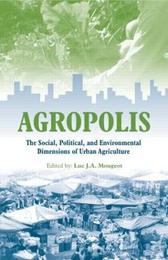
|
Agropolis: The Social, Political and Environmental Dimensions of Urban Agriculture
Paperback
Main Details
| Title |
Agropolis: The Social, Political and Environmental Dimensions of Urban Agriculture
|
| Authors and Contributors |
Edited by Luc.J.A. Mougeot
|
| Physical Properties |
| Format:Paperback | | Pages:304 | | Dimensions(mm): Height 234,Width 156 |
|
| Category/Genre | Agriculture and farming |
|---|
| ISBN/Barcode |
9781844072323
|
| Classifications | Dewey:630.1732 |
|---|
| Audience | | General | | Professional & Vocational | | Tertiary Education (US: College) | |
|---|
| Illustrations |
Figures, tables, index
|
|
Publishing Details |
| Publisher |
Taylor & Francis Ltd
|
| Imprint |
Earthscan Ltd
|
| Publication Date |
1 July 2005 |
| Publication Country |
United Kingdom
|
Description
Urban agriculture is an increasingly popular practice in cities worldwide. A sustainable future for it is critical, especially for the urban poor of the developing world. This book presents the first findings of original field research projects funded by IDRC's AGROPOLIS International Graduate Research Awards on Urban Agriculture. Countries studied include Argentina, Botswana, Ci? te d'Ivoire, Cuba, France,Togo,Tunisia, the UK and Zimbabwe.Together, these studies examine concrete strategies to better integrate 'city farming' into the urban landscape.
Author Biography
Luc J A Mougeot is Senior Program Specialist at the International Development Research Centre (IDRC), where he initiated the Cities Feeding People initiative in 1997.
Reviews"Agropolis present nine research studies that explore diverse urban agricultural environments in five African and two Latin American countries, plus one British and one combined French-Tunisian study, with introductory and conclusive essays by Mougeot. These essays discuss environments that are far removed from the small, sustainable model sometimes presented in the US as an antidote to modern industrial agriculture--those in which (1) urban agriculture is seen as a means of providing food for thickly populated areas where the transportation infrastructure is much less sophisticated, (2) local resources are used as inputs, and (3) there is significant impact on the social and economic fabric of the urban locale, together with active involvement from official of NGO bodies. The case studies are detailed and rigorous and, as Mougeot points out, suggest a need for more experimentation in this nascent area of study to examine such factors as local policy-making groups and socio-biodiversity. They also suggest an opportunity for substituting action research for more traditional analysis. Summing UP: Recommended. Comprehensive collections in agriculture, economics, and sociology supporting upper-level undergraduates and above."--L. S. Cline, Missouri State University in CHOICE
|